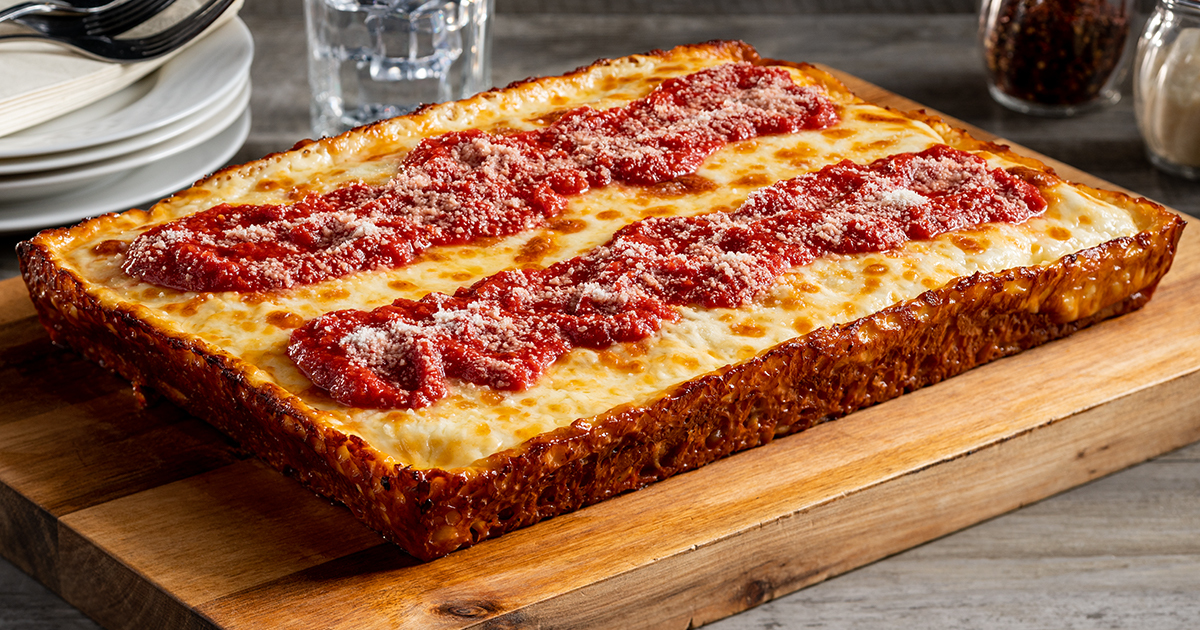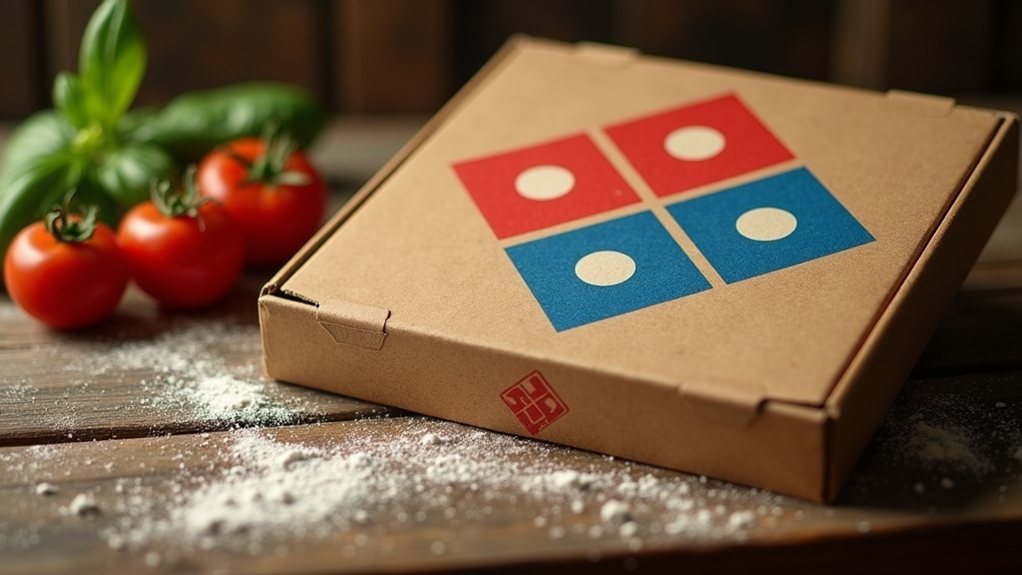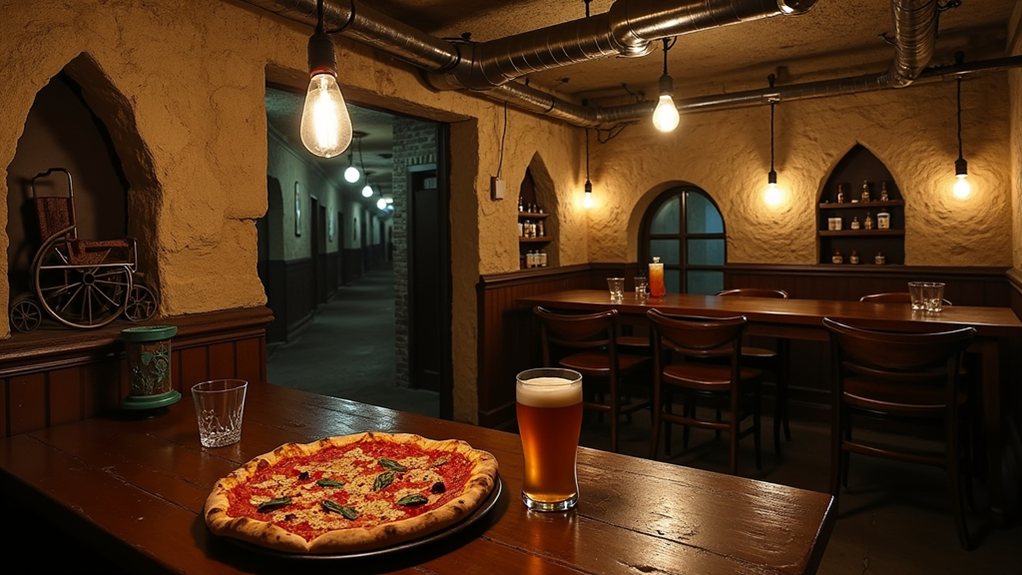I’ve spent years perfecting my Detroit-style pizza technique, and I’m ready to share my secrets with you. The magic lies in a high-hydration dough that creates that distinctive crispy yet airy texture that’s impossible to resist. While many home cooks struggle with soggy centers or burnt edges, a few critical adjustments to your ingredients, fermentation time, and baking method can transform your results. Want to know why professional pizzaiolos use specific pans and cheese combinations?
The Secret Behind Detroit Style Pizza’s Distinctive Texture

The magic of Detroit-style pizza lies in its beautifully contradictory texture, which has earned it a devoted following among pizza enthusiasts nationwide.
What creates this distinctive character is the harmonious balance of a crispy exterior and a soft, airy interior.
I’ve found that high hydration in the dough (around 70%) combined with proper proofing techniques yields that perfect contrast.
The secret weapon? A well-oiled pan that conducts heat efficiently, creating caramelized, crispy edges while maintaining a chewy center.
This textural duality isn’t accidental—it’s engineered through precise fermentation times and baking temperatures that transform simple ingredients into something extraordinary.
The rectangular crust characteristic of authentic Detroit-style pizza contributes to the increased edge surface area where cheese can caramelize perfectly.
Essential Ingredients for Authentic Detroit-Style Dough
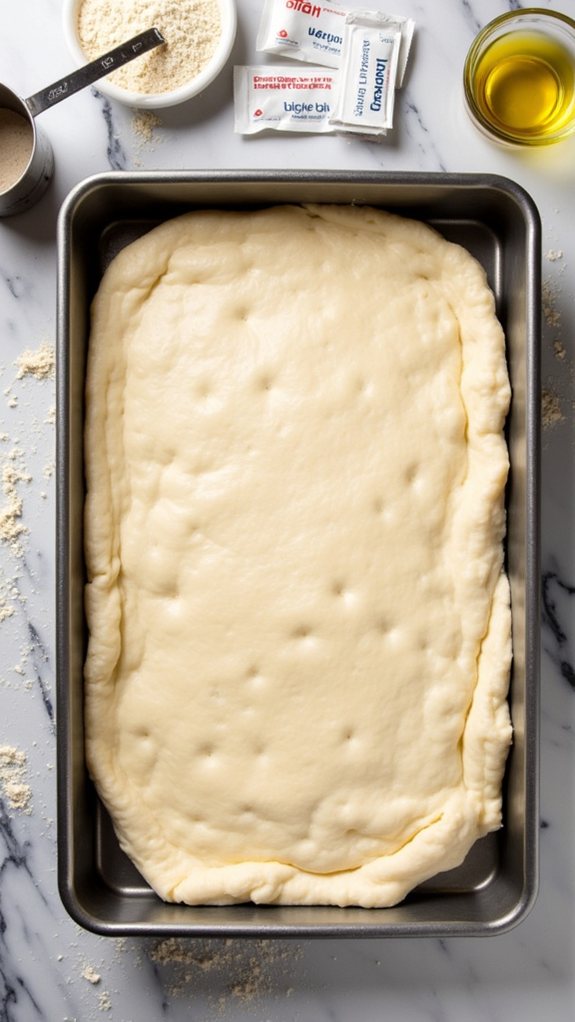
Building upon those textural foundations, let’s examine what makes authentic Detroit-style pizza dough truly special. The secret lies in a precise balance of simple yet critical ingredients that work together to create that unmistakable chew and crisp edge.
- Bread flour (365g) provides higher protein content for better structure
- High hydration (250g water) creates an airy, open crumb
- Minimal yeast (3g) allows for slower fermentation and flavor development
- Proper salt ratio (9g) improves both flavor and dough strength
I’ve found this combination delivers consistently excellent results, whether you’re doing a quick same-day bake or allowing for that flavor-boosting overnight cold ferment. The rectangular shape and caramelized crust are hallmarks of this pizza style that originated in Detroit’s industrial landscape.
Mastering the Fermentation Process for Maximum Flavor

While many home bakers rush the fermentation process, I’ve found that it’s actually the most vital factor in developing that signature Detroit pizza flavor.
After mixing your sticky, high-hydration dough, give it time to work its magic – at least 30 minutes for the initial fermentation before performing those essential strength-building folds.
For truly remarkable results, consider the overnight cold fermentation option. This option allows complex flavors to develop while improving the dough’s texture.
Remember, patience pays off here; when you see that dough double in size, you’ll know you’re on your way to pizza perfection.
The fermentation is where your dough comes alive.
Similar to Neapolitan pizza, achieving a soft and elastic dough is essential for that perfect texture and chew.
Proper Pan Selection and Proofing Techniques
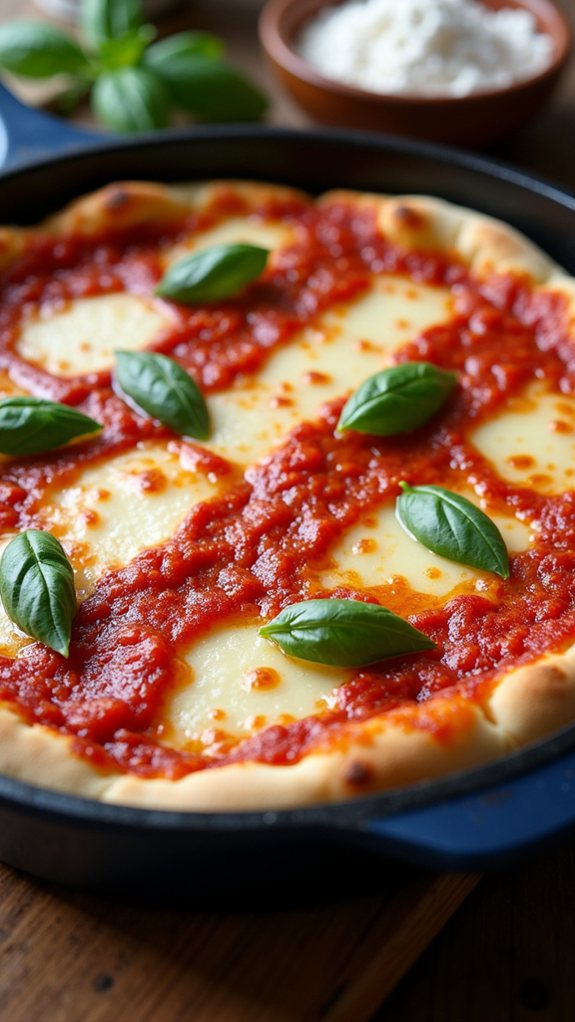
Success in Detroit-style pizza making begins with selecting the right pan, which I’ve found makes all the difference between good and exceptional results.
I strongly recommend Lloyd brand pans for their heat conductivity and durability, but any 8×10 or 9×13 blue steel pan will work in a pinch.
For ideal proofing, follow these crucial steps:
- Generously oil your pan before adding the dough
- Dimple gently with fingertips rather than aggressively degassing
- Cover with plastic wrap during the 30-minute proof
- Look for the dough to rise about 1 inch, filling the corners
Creating the Perfect Concentrated Tomato Sauce

With your dough properly proofed in the right pan, let’s shift our focus to the sauce—a signature element that sets Detroit-style pizza apart from its cousins. Concentration is key; a watery sauce ruins even the most perfect crust.
| Ingredient | Amount | Purpose |
|---|---|---|
| Crushed tomatoes | 28 oz can | Base flavor |
| Tomato paste | 50g | Thickening agent |
| Salt | 7g | Flavor booster |
| Sugar | 12g | Balances acidity |
After blending with herbs and simmering for 10 minutes, you’ll know it’s ready when your spatula leaves a stiff trail. This thicker consistency prevents sogginess and creates beautiful sauce islands on your cheese.
Cheese Selection: Why Wisconsin Brick Cheese Makes a Difference

Cheese, arguably the most crucial component of any Detroit-style pizza, demands careful selection for authentic results. After testing multiple varieties, I’ve found Wisconsin brick cheese offers that perfect balance of saltiness, funk, and reliability that defines true Detroit-style pizza.
- Wisconsin brick cheese provides a saltier, more aged flavor profile than mozzarella.
- Grated (not ground) cheese delays browning, preventing premature burning in home ovens.
- Full-fat mozzarella works as a serviceable substitute when brick cheese isn’t available.
- About 125g per pizza creates the ideal cheese-to-dough ratio for that signature crispy, caramelized edge.
When you’re aiming for authenticity, these cheese considerations make all the difference between good and extraordinary results.
The Two-Stage Baking Method for Crispy-Yet-Chewy Results
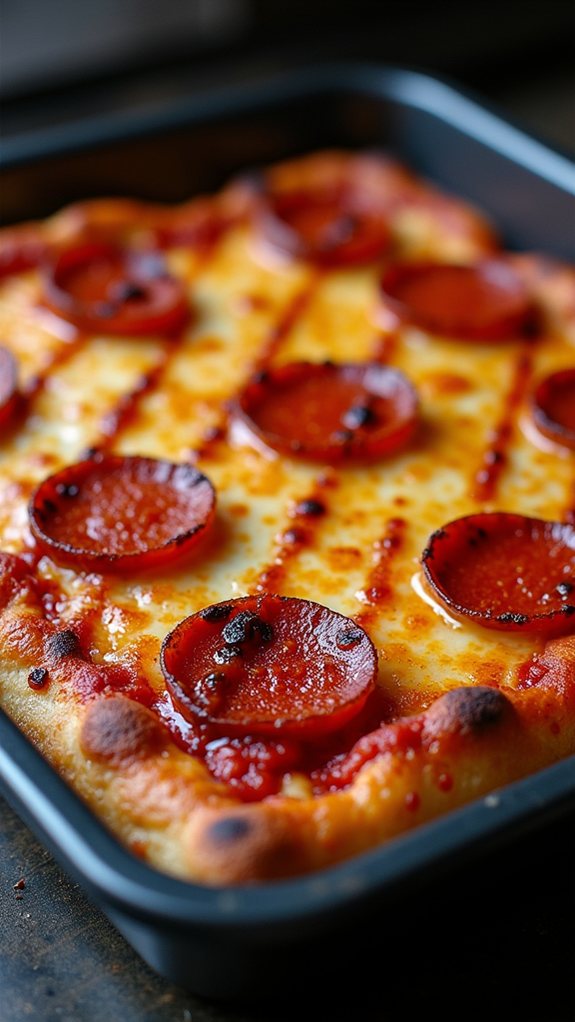
Achieving the paradoxical texture that makes Detroit-style pizza so addictive—a crispy exterior with a chewy, airy interior—depends entirely on how you manage the baking process.
I’ve found that a two-stage approach works magic here.
First, bake your pizza on preheated steel for 10-14 minutes at 500°F, which jumpstarts the development of the bottom crust.
Then comes the vital step: after removing the pizza from its pan, let it rest on a wire rack for 5 minutes before returning it to the steel for 3-5 minutes more.
This final heating creates that brittle, crunchy edge while preserving the bready chew inside.
FAQs
Can I Use a Food Processor to Mix the Dough?
Yes, I’d recommend a food processor for mixing pizza dough. It’ll save you time while giving excellent results. Just pulse until ingredients combine, then process briefly until smooth.
How Long Will Leftover Detroit-Style Pizza Keep?
I recommend consuming leftover Detroit-style pizza within 3-4 days when refrigerated. For best results, reheat it on a hot pan or in the oven—never microwave if you value that crispy texture!
What Are Good Toppings for Authentic Detroit-Style Pizza?
For authentic Detroit-style pizza, I recommend pepperoni, Italian sausage, mushrooms, onions, and green peppers. The classic approach keeps toppings simple to let the crispy crust and Wisconsin brick cheese shine through.
Can I Freeze the Dough for Future Use?
Yes, I can freeze my Detroit-style pizza dough! After letting it complete the initial fermentation, I’ll wrap it tightly and freeze it. Thaw overnight in the fridge before using it.
Is There a Gluten-Free Version of Detroit-Style Pizza?
I haven’t developed a gluten-free version of this recipe yet, but you could experiment with cup-for-cup gluten-free flour blends that contain xanthan gum for structure and elasticity.
